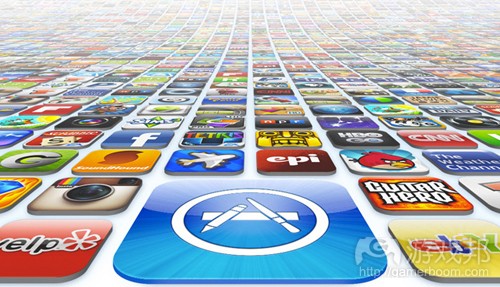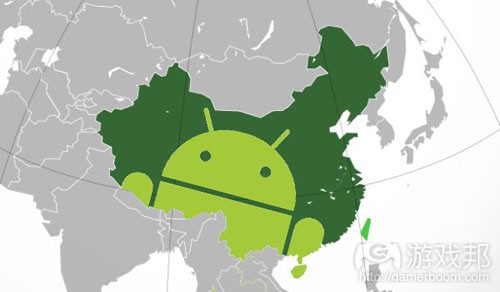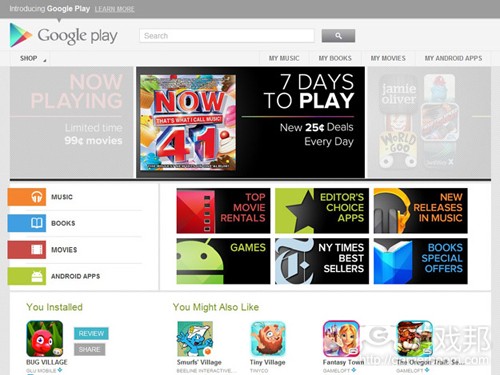每日观察:关注2013年应用下载量达700亿次(3.5)
1)ABI Research最新报告预测,2013年全球移动应用下载量将达700亿次,其中Android应用占比58%,iOS应用占比41%。
届时苹果iPhone在智能手机应用下载量中占比33%,iPad在平板电脑应用下载量中占比75%,而Android平板电脑应用下载量在2013年将仅占比17%。
2013年Android应用总下载量为350亿次,而iOS应用则是290亿次。
2)市场分析公司IDC最近报告指出,智能手机出货量将在2013年首次超越功能性手机,预计今年智能手机出货量将达9.186亿部,在全球手机出货量中占比50.1%。
预计到2017年底,全球智能手机出货量将达15亿部,在2017年全球手机出货量中占比超过三分之二。
中国仍将是全球最大的智能手机市场,并以低端的Android智能手机为主导;而英美两国智能手机市场则趋于饱和,在未来数年的智能手机市场发展将有所减缓。
3)游戏开发者大会(GDC)针对去年参会的2500名开发者调查结果显示,53%受访者自我标榜为独立开发者,46%受访者表示为某家公司效力,仅有24%将与发行商合作推出下载游戏。
38%开发者上一款游戏是面向智能手机和平板电脑,55%正针对这两个平台开发游戏,34.8%开发者针对PC和Mac发布上一款游戏,48%正面向PC和Mac开发游戏。
仅有13.2%开发者正面向Xbox 360平台开发游戏,有14%计划针对这一平台发布下款游戏,仅有13%开发者针对PS 3开发游戏,12.4%计划面向这一平台发布下款游戏;有11%开发者有意面向下一代索尼和微软主机开发游戏,有4.6%正开发Wii U游戏,有6.4%将针对Wii U发布下一款游戏。
58%表示智能手机是自己将来瞄准的开发平台,而基于PC的TV主机(游戏邦注:例如Steam Box)的支持率也达到45%,OUYA这类基于Android的主机支持率则是37%,PS 4支持率为27%,微软下一代主机的支持率为29%,Wii U支持率仅为13%,3DS支持率则是5%。
4)据PCR报道,日本政府日前提醒本国用户不要通过Google Play下载应用,原因是该国Google Play官方网站曾出现一款窃取用户资料的应用(名为“性感模特壁纸”)。
该应用在被Google Play移除之前已被下载50万次,要求访问用户所在地理位置,电邮地址和终端信息,并将这些信息传送给第三方服务器。
日本相关部门建议用户最好通过由KDDI、Docomo和软银等运营商开放的应用商店下载内容,因为运营商有相应的审查制度。
5)据pocketgamer报道,俄罗斯搜索引擎巨头Yandex(全球第四大搜索引擎)在日前的2013全球移动大会上宣布,将推出自己的Android应用商店Yandex.Store(首批上线应用超过5万款),直接与谷歌Google Play角逐市场。
该应用商店UI已推出俄语、英语、法语、德语、西班牙语、意大利语、乌克兰语、土耳其语版本,未来还将推出更多语言支持。
Yandex预计该应用商店多数流量将来自预装设备,但也支持用户直接下载这一应用。开发者可通过类似于Google Play的自助流程向其发布应用,但其发布内容需通过卡巴斯基的审核。
除了应用商店和搜索引擎之外,Yandex还推出了地图、绑定计费解决方案等配套服务。(本文为游戏邦/gamerboom.com编译,拒绝任何不保留版权的转载,如需转载请联系:游戏邦)
1)We will download 70 billion mobile apps in 2013 (50% Android, 41% iOS)
John Koetsier
In 2013, we’ll download 10 apps for every single woman, man, and child on planet Earth.
Half of those apps will be Android apps, which will have 58 percent smartphone app share, according to ABI Research, and 41 percent of those will be iOS apps. Apple’s iPhone will account for 33 percent of smartphone app downloads, ABI says, while the company’s iPad will take 75 percent of tablet app downloads. Windows Phone and tablet devices will account for the majority of the rest, with BlackBerry taking about a 2 percent share.
Add it all up, and about 35 billion Android apps will load to devices in 2013, plus another 29 billion iOS apps.
That is a lot of apps.
While Google’s Android is clearly doing well in smartphones, the future of its tablet aspirations is not yet as clear. Only 17 percent of tablet downloads in 2013 will be on Android tabs, ABI says, which compares poorly to iPad’s 75 percent tablet app share.
“The most pressing issue for Google is how much of this handset momentum will ultimately trickle down to tablets, where Apple is holding the fort remarkably well,” ABI analyst Aapo Markkanen said in a statement.(source:venturebeat)
2)Smartphone shipments to outstrip feature phones in 2013
by Daniel Gumble
First time such an occurrence has happened in the mobile phone market on an annual basis.
Smartphone shipments are expected to outship feature phone shipments for the first time ever on an annual basis in 2013, according to market analyst IDC.
The firm predicts that vendors will ship 918.6 million smartphones this year, equating to 50.1 per cent of the total number of global mobile phone shipments.
Furthermore, by the end of 2017, IDC forecasts 1.5 billion smartphones will be shipped worldwide, accounting just over two-thirds of the total mobile phone forecast for the year.
China is set to remain the world’s largest market for smartphones; specifically low-cost handsets based on the Android operating system. “While we don’t expect China’s smartphone growth to maintain the pace of a runaway train as it has over the last two years, there continue to be big drivers to keep the market growing as it leads the way to ever-lower smartphone prices and the country’s transition to 4G networks is only just beginning,” said Melissa Chau, senior research manager, IDC Asia/Pacific. “Even as China starts to mature, there remains enormous untapped potential in other emerging markets like India, where we expect less than half of all phones shipped there to be smartphones by 2017, and yet it will weigh in as the world’s third largest market.”
Elsewhere, Brazil is another key market where smartphone growth is expected to remain high over the course of the forecast, as its economic circumstance improves. “Brazilians have yet to turn in their feature phones for smartphones on a wholesale basis,” said Bruno Freitas, Consumer Devices Research Manager, IDC Brazil. “The smartphone tide is turning in Brazil though, as wireless service providers and the government have laid the ground work for a strong smartphone foundation that mobile phone manufacturers can build upon.”
With smartphone users now accounting for the majority of all mobile phone users in the US, IDC expects slower growth in the coming years. Similarly, the UK’s smartphone market has slowed in recent quarters as penetration has risen and economic growth has failed to gather significant pace.(source:mobile-ent)
3)Indies on the rise, smartphone and PC development growing, GDC poll says
By Dant Rambo
A recent survey conducted by the Game Developer’s Conference brought forth some interesting statistics about the current state of game development. Over 2,500 developers were polled, all of which either attended last year’s GDC or plan to attend this year. Of everyone polled, 53% labeled themselves as indie developers. And while the definition of an indie developer is sometimes debated, 46% of those polled said they worked at a company of ten or less, with only 24% working with a publisher to release their last game. It doesn’t get much more indie than that!
Developers were also asked to state which platforms they develop for, and smartphones and tablets took the lead here. 38% of developers said they released their last game for smartphones and tablets, and 55% said they’re currently at work on a game for those platforms. PCs and Macs took second in this category, with 34.6% of developers having released their last game on those platforms, and 48% at work on games for them now.
All good news so far, right? Well, only if you aren’t Sony, Microsoft, or Nintendo. Only 13.2% of developers said they were working on a game for Xbox 360, with only 14% planning on releasing their next game for the platform. The PlayStation 3 fared no better, with only 13% of developers saying they were developing for the console, and only 12.4% aiming to release their next game on it. As for next-gen consoles from Sony and Microsoft, an equal 11% of those polled said they were working on a game for them. The Wii U came in dead last, with 4.6% at work on a Wii U game, and 6.4% releasing their next game on the platform.
37% of those polled expressed interest in developing for Android-based consoles like GameStick and OUYA
One of the most intriguing statistics came from a question about which platforms developers were most interested in developing for. 58% of those polled chose smartphones, but “PC-based TV consoles” like the Steam Box came in second at 45%, with Android-based consoles such as the OUYA coming in at 37%. Consoles fared a bit better here, with 27% expressing interest in developing for the PS4, and 29% interested in Microsoft’s next-gen console. Sadly, the Wii U had an interest level of 13%, and the 3DS a paltry 5%
Mind you, this may not be indicative of the current state of game development. Not all of the major console developers attend GDC, which may have had an effect on the data. Regardless, it’s clear that interest in smartphones and tablets has yet to wane, and future platforms like the Steam Box and OUYA will likely be a hotbed for indie game development.(source:gamezebo)
4)Japanese government: ‘Don’t use Google Play’
by Daniel Gumble
Warning follows discovery of info-stealing app on Google’s official Play site.
Japan is warning its Android users to avoid Google Play and download their apps from third party operator-run stores instead, PCR has reported.
The warning comes after a prolific info-stealing app was discovered on Google’s official Play site.
Tokyo’s Information Technology Promotion Agency (IPA) alerted Android users last week to an app named ‘sexy porn model wallpaper’, which had already been downloaded 500,000 times from Google Play before it was removed.
The app requests user permission to access location details, email address and terminal information, which it then sends over to a third part server while distracting you with sexy girls.
The government-backed body has now warned users off of Google Play and is urging them to visit app stores run by mobile operators such as KDDI’s ‘au Smart Path’, Docomo’s ‘D Market’ and ‘Softbank’s ‘Yahoo! Market’. “In these markets, operators carry their own checks of the app,” said IPA.
This is not great news for Google, having recently responded to previous security criticism by launching an app verification service for its Play store.(source:mobile-ent)
5)Russian search giant goes head-to-head with Google Play, launching Yandex.Store
by Jon Jordan
Announced at Mobile World Congress 2013, Russia search giant Yandex is now competing directly with Google Play.
It’s released its Yandex.Store, an on-device store for Android apps and games, which launched with over 50,000 titles.
High profile apps on the store include Foursquare, Cut the Rope, Pudding Monsters and Angry Birds.
The store’s UI has been localised in Russian, English, French, German, Spanish, Italian, Ukrainian and Turkish, with more languages coming soon.
Reskin and serve
As you’d expect initial support has come from Russian companies such as operator MegaFon, which launched its white label version of the store – called GetUpps! – in February.
Manufacturers supporting Yandex.Store include Oppo, PocketBook, Explay, te?et, WEXLER, 3Q and Qumo.
Yandex expects that the majority of traffic from Yandex.Store will come as it’s pre-installed on devices, but consumers can also directly download the store if they want to.
In terms of developer getting content onto the store, it’s a similar self-serve process to Google Play, although Kaspersky Lab checks all submissions for malware.
All about search
The reason for Yandex’s move is that Russia’s largest – and the world’s fourth largest – search engine wants to undercut Google’s market share for search, especially in regions such as Russia, Turkey and Asia.
Yandex.Store enables it to do this as it’s free for companies to integrate and rebrand, and Yandex is prepared to share part of the 30 percent of app store transactions it collects with operators and/or OEMs in order to boost its wider search business.
Indeed, it hopes some handset manufacturers will remove Google Play from their devices, completely replacing it with Yandex.Store.
As well as the store and search, Yandex also offers services such as maps and its own integrated billing solution.(source:pocketgamer)












































 闽公网安备35020302001549号
闽公网安备35020302001549号